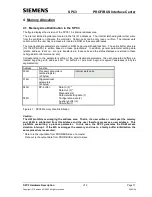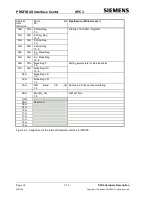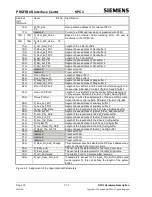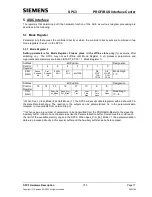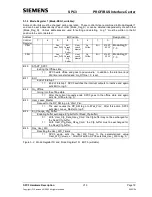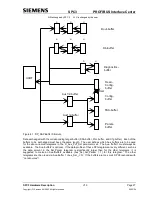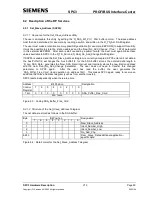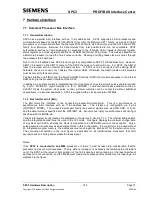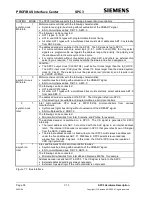
SPC3
PROFIBUS Interface Center
SPC3 Hardware Description
V1.3
Page 25
Copyright (C) Siemens AG 2003 All rights reserved.
2003/04
5.4 Watchdog Timer
5.4.1 Automatic Baud Rate Identification
The SPC3 is able to identify the baud rate automatically. The „baud search“ state is located after each
RESET and also after the watchdog (WD) timer has run out in the ‘Baud_Control_state.’
As a rule, SPC3 begins the search for the set rate with the highest baud rate. If no SD1 telegram, SD2
telegram, or SD3 telegram was received completely and without errors during the monitoring time, the
search continues with the next lowest baud rate.
After identifying the correct baud rate, SPC3 switches to the “Baud_Control” state and monitors the baud
rate. The monitoring time can be parameterized (WD_Baud_Control_Val). The watchdog works with a
clock of 100 Hz (10 msec). The watchdog resets each telegram received with no errors to its own station
address. If the timer runs out, SPC3 again switches to the baud search state.
5.4.2 Baud Rate Monitoring
The located baud rate is constantly monitored in ‘Baud_Control.’ The watchdog is reset for each error-free
telegram to its own station address. The monitoring time results from multiplying both
‘WD_Baud_Control_Val’ (user sets the parameters) by the time base (10 ms). If the monitoring time runs
out, WD_SM again goes to ‘Baud_Search’. If the user carries out the DP protocol (DP_Mode = 1, see Mode
register 0) with SPC3, the watchdog is used for the “DP_Control’ state, after a ‘Set_Param telegram’ was
received with an enabled response time monitoring ‘WD_On = 1.’ The watchdog timer remains in the baud
rate monitoring state when there is a switched off ‘WD_On = 0’ master monitoring. The PROFIBUS DP
state machine is also not reset when the timer runs out. That is, the slave remains in the DATA_EXchange
state, for example.
5.4.3 Response Time Monitoring
The ‘DP_Control’ state serves response time monitoring of the DP master (Master_Add). The set
monitoring times results from multiplying both watchdog factors and multiplying the result with the
momentarily valid time base (1 ms or 10 ms):
TWD = (1 ms or 10 ms) * WD_Fact_1 * WD_Fact_2 (See byte 7 of the parameter setting telegram.)
The user can load the two watchdog factors (WD_Fact_1, and WD_Fact_2) and the time base that
represents a measurement for the monitoring time via the ‘Set_Param telegram’ with any value between 1
and 255.
EXCEPTION: The WD_Fact_1=WD_Fact_2=1 setting is not permissible. The circuit does not check
this setting.
Monitoring times between 2 ms and 650 s - independent of the baud rate - can be implemented with the
permisible watchdog factors.
If the monitoring time runs out, the SPC3 goes again to ‘Baud_Control,’ and the SPC3 generates the
‘WD_DP_Control_Timeout-Interrupt’. In addition, the DP_State machine is reset, that is, generates the
reset states of the buffer management.
If another master accepts SPC3, then there is either a switch to ‘Baud_Control” (WD_On = 0), or there is a
delay in ‘DP_Control’ (WD_On = 1), depending on the enabled response time monitoring (WD_On = 0).
Summary of Contents for SPC3
Page 1: ...SIMATIC NET SPC3 Siemens PROFIBUS Controller Hardware Description Date 2003 04 09 ...
Page 2: ......
Page 67: ......

